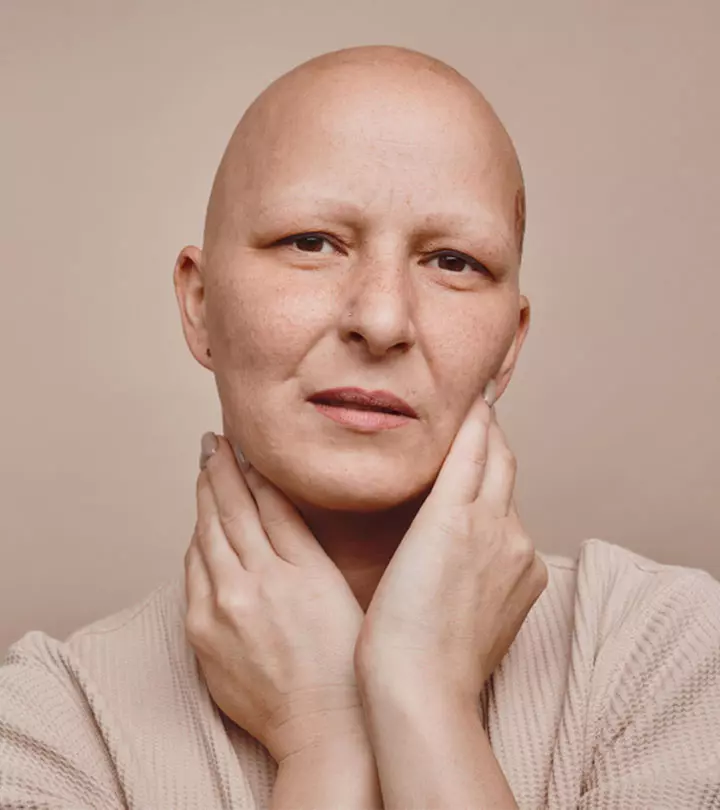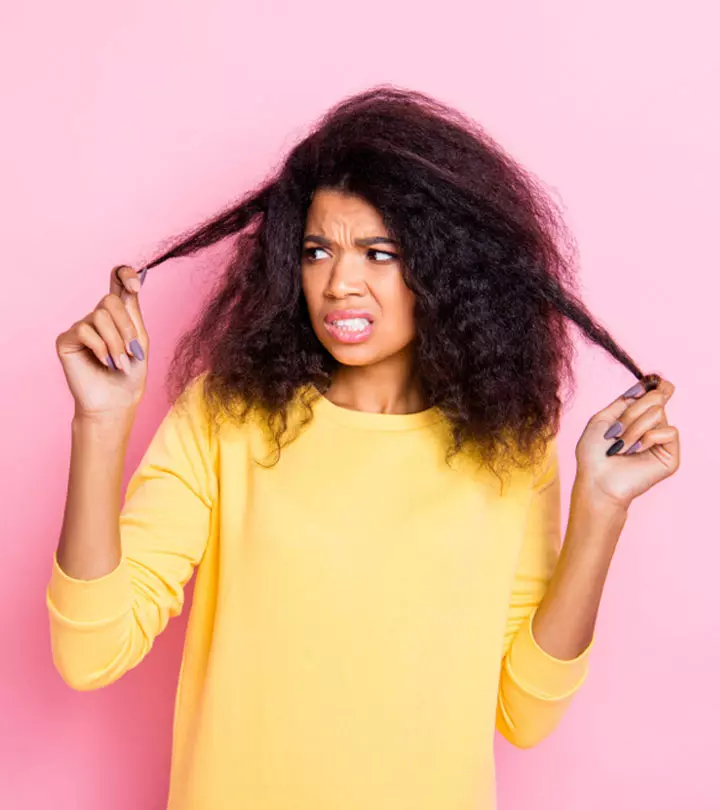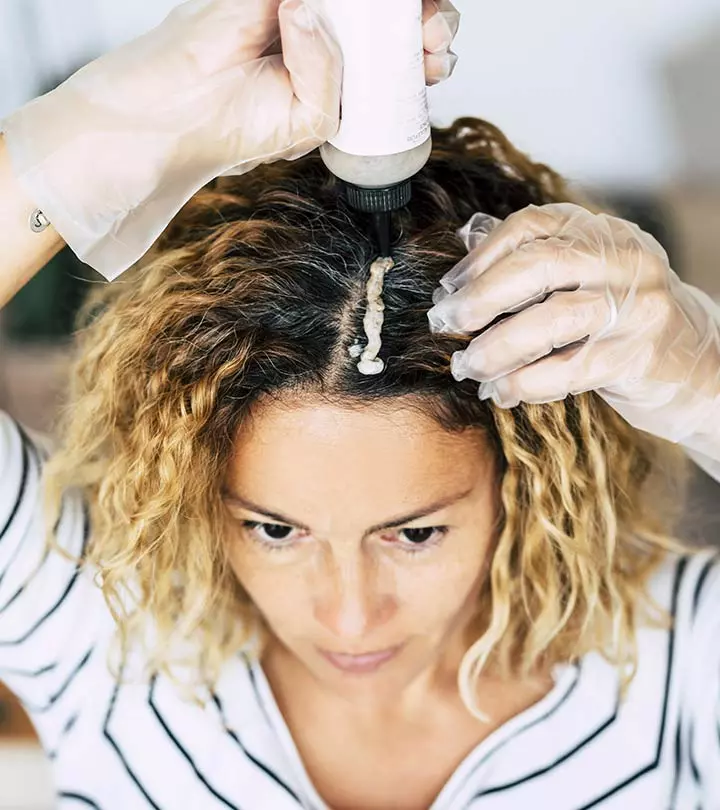PRP Treatment For Hair Loss: Is It Safe And Does It Work?
Know all about the platelet-rich plasma therapy procedure, benefits, and risks.

Image: Shutterstock
The number of people taking PRP treatment for hair growth is constantly on the rise, thanks to its effectiveness and affordability. The PRP (Platelet-Rich Plasma) therapy involves injecting platelets (separated from your blood) into your scalp in the affected area. These platelets stimulate hair follicles and induce re-growth of hair. According to a study, this therapy is completely safe and goes a long way in increasing the number of hair strands (1), (2), (3).

In this article, we will find out more about PRP therapy, its benefits, potential side effects, and the costs involved. We will also explore the best candidate for this treatment and many more. So, let’s jump right in!
In This Article
What Is PRP Treatment For Hair Loss?
Platelet-Rich Plasma (PRP) treatment helps stimulate hair growth in areas where your hair is thinning. This new-age hair regrowth treatment is a minimally invasive procedure carried out by licensed dermatologists. In this procedure, platelets are extracted from the patient’s blood and injected into the scalp. The platelets then work on the hair follicles to strengthen and revive them and trigger hair growth. PRP, unlike hair transplant, is not very costly and requires no downtime for surgical recovery.
Scroll down to find out how this procedure is carried out.
Key Takeaways
- Platelet-rich plasma (PRP) therapy is a minimally invasive procedure where platelets collected from your blood are injected into your scalp to facilitate growth.
- PRP therapy offers visible results after the first session, leaves no scars, and is cheaper than a hair transplant.
- However, you may experience a few side effects, such as mild pain, itching, and swelling at the site of injection.
- While it may not be a permanent solution, it is a great way to stimulate hair growth in people dealing with hair fall and androgenic alopecia.
PRP Procedure – How Is PRP Done?
The procedure of PRP or platelet-rich plasma therapy for hair is quite simple. It is a minimally invasive three-step process:
- Step 1 – Draw Blood: A licensed medical professional draws blood from your arm and stores it in a sterile, airtight tube.
- Step 2– Separate Platelets: A lab technician puts the tube in a centrifuge and spins it for 10 minutes. This separates the red blood cells or RBCs (that settle at the bottom of the tube), serum (top layer), and platelets (middle layer).
- Step 3 – Inject Platelets: The platelets are drawn from the tube with the help of a syringe. The doctor then injects the platelets into the scalp wherever there is hair thinning and balding.
Clearly, it is a simple process. But, how does it work to help revive the hair follicles and stimulate hair growth? Let’s find out in the next section.
How Does PRP Stimulate Hair Growth?
PRP treatment for hair works on the same principle as wound healing. When you have a wound, the platelets in your blood release numerous growth factors and other biochemicals that help activate fibroblasts, collagen, and other factors to build a new layer of skin. The activated platelet-rich plasma injected in the scalp helps release the following growth factors to treat hair thinning, hair loss, and baldness:
- Platelet-derived growth factor (PDGF)
- Transforming growth factor-beta (TGF-β)
- Vascular endothelial growth factor (VEGF)
- Epidermal growth factor (EGF)
- Insulin-like growth factor-1 (IGF-1)
These growth factors boost the cell proliferation (cell growth) of the dermal papilla, differentiation (forming specialized cells, for e.g., skin cells), and chemotaxis (movement in response to chemical stimulus), increase permeability, reduce inflammation, and prevent hair cell death (apoptosis).
The growth factors in PRP also act on the stem cells that are found in the bulge area of follicles. This results in neovascularization and folliculogenesis, which is extremely important for hair regeneration (2).
Basically, PRP hair treatment helps recruit all the growth factors and biochemicals required to improve follicle vascularization, inhibit cell apoptosis, prolong the hair cycle or anagen phase, boost hair regrowth, improve blood supply, and reduce inflammation.
However, more research is required to establish the exact mechanism of action of PRP treatment for hair.
 Pro Tip
Pro TipNow that you know all about how PRP treatment works, let’s check out what kind of results it delivers.
PRP Results – Before And After Treatment
PRP treatment for hair loss has been quite successful for many people. Here are a few snapshots of people who have undergone PRP treatment showing their hair before and after PRP treatment results.



Cost Of PRP Treatment
The cost of PRP treatment ranges between $1500 to $3500 for the first three sessions. Thereafter, each session will cost you around $400. However, the cost depends on:
- Geographic location
- Equipment used (roller or injection)
- The reputation of the treatment center
- The doctor’s expertise
- The facilities at the treatment center
If you want to give PRP treatment a shot, we recommend that you research the treatment facility, their success rate, their doctors, and compare the prices at various treatment centers in your city. But, how many sessions do you need to see a visible difference? Scroll down to find out!
How Many Sessions Of PRP Treatment Do You Need?
PRP treatment for hair loss is not a one-time treatment. You need to undergo at least 4 sessions to see full growth. You will start seeing a difference in hair growth and thickness right after the first session.

Many users need to go back for a session of PRP treatment every 6 months. The number of sessions also depends on whether you are eating right, taking the supplements prescribed by the doctor, and taking care of your hair after the initial sessions.
A systematic review evaluated the effectiveness of platelet-rich plasma (PRP) in treating androgenic alopecia (AGA) in 435 men and women. The overall outcome was positive, with 26 people who had 5 sessions every 2-3 weeks having 1.9% control.
However, PRP treatment is not suitable for everybody. Check out the next section to find out if it will work for you.
On Whom Does PRP Treatment Work?
PRP or platelet-rich plasma treatment for hair loss works best on people who have started experiencing hair fall recently. There are many studies on people with androgenic alopecia or male pattern baldness showing promising results. Androgenic alopecia is a genetic condition that is affected by hormones. Two studies were done on people with alopecia areata – an auto-immune disorder that causes hair thinning and balding – also showed that PRP therapy may be an effective treatment for the same (4), (5). However, more research is required to prove the same. Also, remember that PRP treatment does not cure balding.
If a part of your scalp has started thinning out recently, talk to your dermatologist to see if PRP treatment is the best option.
 Fun Fact
Fun FactPRP therapy is a budding and effective hair loss treatment. But, is it a permanent solution for hair loss and balding? Find out in the next section.
Is PRP Hair Treatment A Permanent Solution?
No, PRP hair treatment is not a permanent solution. After the initial 3-4 sessions, you may not have to go back for another 6 months. Your hair roots will become stronger, and you will experience reduced hair fall. Overall, you will see a visible difference in your hair growth and thickness. However, you may have to go for a session after 6 months of the initial treatment. Sticking to the doctor-recommended PRP therapy sessions can prevent a second initiation of the therapy and keep your hair healthy.
PRP treatment may require several initial sessions and 1-2 sessions every year after that. But for those looking for a cost-effective hair loss treatment, PRP treatment has many benefits. Check them out in the next section.
Benefits Of PRP Treatment For Hair Loss
- Minimally invasive. You do not need to undergo surgery.
- It is a quick procedure.
- It is cheaper than hair transplantation.
- You can see the results right after the first session.
- It uses your own cells, thereby reducing the risk of transferring communicable diseases and allergic reactions.
- It is non-scarring.
- It does not require any recovery time.
- It can also be used to regenerate eyebrows or men’s facial hair.
- It improves your appearance and quality of life.
But every coin has a flip side. PRP treatment, like any other treatment, has a few risks that you must be aware of. Scroll down to find out all about them.
Are There Any Risks Associated With PRP Treatment?
PRP treatment for hair loss is a minimally invasive procedure. However, you may experience the following adverse effects:
- Mild pain at the site of injection.
- Headache and mild swelling.
- Itching and tenderness on the scalp.
- Slight bleeding at the site of injection.
Imane Belle, a YouTuber, tried the PRP treatment and shared the experience in a video. She said, “In the beginning it was painful I won’t lie like painful but after a while you do get used to it but the pain depends on your pain threshold I think my pain threshold is medium so there you go (i).

Takeaway
Hair loss and hair thinning are medical conditions that affect many people around the world. PRP treatment is an effective and cheap hair loss treatment conducted by licensed dermatologists. Many research studies have backed it, saying that it improves hair density, hair count, and the health of the hair shaft significantly.
PRP treatment is used to stimulate hair growth on the scalp where the hair grows thin. Platelets are extracted from the patient’s blood and injected into the scalp. These platelets release growth factors that help treat hair thinning, baldness, and hair loss. However, this is not a permanent solution. The PRP treatment for hair growth is minimally invasive and non-scarring. But more research is required to learn how it impacts different people. If you are experiencing hair loss, baldness, or hair thinning, consult your doctor on what your first line of treatment should be. In some cases, a simple change in diet or nutrient supplements can be enough to stimulate hair growth. In other situations, your doctor may recommend a hair transplant or PRP.
Frequently Asked Questions
Can I apply oil after PRP?
It is recommended to avoid using oils before and after a PRP treatment for at least a day or two. Consult your doctor to know exactly how long you should avoid using oils, creams, and other hair products.
Can I use PRP and minoxidil together?
Yes, you can pair PRP and minoxidil to stimulate hair regrowth, but only if your doctor recommends it.
Which is better: PRP or laser therapy?
Both are effective therapies for stimulating hair growth. However, laser treatment for hair growth is recommended for people who have more localized hair loss whereas PRP is best for a general boost in hair volume.
Can PRP cause tumors?
Since the platelets are taken from the patient’s body, unless the patient has or had a tumor, PRP therapy does not cause tumors.
PRP Hair Treatment helps combat hair loss while revitalizing hair growth. Check out the inspiring before-and-after story and the potential of this revolutionary hair loss treatment in this video. Tap to watch!
Personal Experience: Source
StyleCraze's articles are interwoven with authentic personal narratives that provide depth and resonance to our content. Below are the sources of the personal accounts referenced in this article.
(i). PRP for Hair Loss (my PRP THERAPY journey)https://www.youtube.com/watch?v=cypexpUqI28
References
Articles on StyleCraze are backed by verified information from peer-reviewed and academic research papers, reputed organizations, research institutions, and medical associations to ensure accuracy and relevance. Read our editorial policy to learn more.
- Giordano, Salvatore et al. “A Meta-analysis On Evidence Of Platelet-rich Plasma for Androgenetic Alopecia.” International journal of trichology vol. 10,1 (2018): 1-10.
https://www.ncbi.nlm.nih.gov/pmc/articles/PMC5803844/ - Stevens, J, and S Khetarpal. “Platelet-rich plasma for androgenetic alopecia: A review of the literature and proposed treatment protocol.” International journal of women’s dermatology vol. 5,1 46-51.
https://www.ncbi.nlm.nih.gov/pmc/articles/PMC6374694/ - Verma, Kuldeep et al. “A Study to Compare the Efficacy of Platelet-rich Plasma and Minoxidil Therapy for the Treatment of Androgenetic Alopecia.” International journal of trichology vol. 11,2 (2019): 68-79.
https://www.ncbi.nlm.nih.gov/pmc/articles/PMC6463452/ - Singh, Sukhbir. “Role of platelet-rich plasma in chronic alopecia areata: Our centre experience.” Indian journal of plastic surgery : official publication of the Association of Plastic Surgeons of India vol. 48,1 (2015): 57-9.
https://www.ncbi.nlm.nih.gov/pmc/articles/PMC4413492/ - Trink, A et al. “A randomized, double-blind, placebo- and active-controlled, half-head study to evaluate the effects of platelet-rich plasma on alopecia areata.” The British journal of dermatology vol. 169,3 (2013): 690-4.
https://pubmed.ncbi.nlm.nih.gov/23607773/
Read full bio of Anjali Sayee
Read full bio of Eshna Das
Read full bio of Monomita Chakraborty


























Community Experiences
Join the conversation and become a part of our empowering community! Share your stories, experiences, and insights to connect with other beauty, lifestyle, and health enthusiasts.